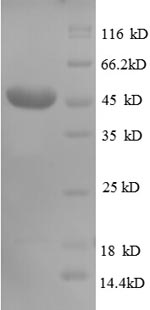Recombinant Human CD320 antigen (CD320) is produced in E. coli as a partial protein covering amino acids 36-231. The protein includes an N-terminal GST tag, which helps with its solubility and purification. The product shows greater than 90% purity as confirmed by SDS-PAGE, ensuring reliable performance in experimental applications. This recombinant protein is for research use only and is not intended for human therapeutic or diagnostic applications.
CD320, also known as the transcobalamin receptor, appears to play a crucial role in how cells take up cobalamin, a form of vitamin B12. It's involved in the cobalamin transport pathway and seems essential for proper cellular metabolism. Research on CD320 may be important for understanding vitamin B12 metabolism and its implications in various biological processes, making it a valuable target in scientific studies.
Potential Applications
Note: The applications listed below are based on what we know about this protein's biological functions, published research, and experience from experts in the field. However, we haven't fully tested all of these applications ourselves yet. We'd recommend running some preliminary tests first to make sure they work for your specific research goals.
Based on the provided information, the recombinant Human CD320 antigen is expressed in E. coli, a prokaryotic system that is generally unsuitable for producing functional eukaryotic membrane receptors like CD320. CD320 is a transmembrane receptor that requires precise folding, proper disulfide bond formation, glycosylation, and membrane integration for its function in transcobalamin transport. The protein is expressed as a partial extracellular fragment (36-231aa) with an N-terminal GST tag and >90% purity. However, E. coli lacks the eukaryotic chaperones, disulfide isomerases, glycosylation machinery, and membrane environment necessary for correct folding of this complex receptor. The large GST tag (~26 kDa) may significantly interfere with the native protein structure. Since activity is unverified, the protein cannot be assumed to be correctly folded or bioactive without experimental validation of its transcobalamin-binding capability.
1. Antibody Development and Validation
The recombinant CD320 fragment can serve as an effective immunogen for generating antibodies that recognize linear epitopes within the extracellular domain, even if the protein is misfolded. The high purity supports immunization protocols. However, antibodies may not recognize conformational or glycosylation-dependent epitopes of native, properly folded CD320 on human cells. Validation against endogenous CD320 from mammalian cells is essential.
2. Protein-Protein Interaction Studies
This application is high-risk without proper folding validation. While the GST tag enables technical feasibility for pull-down assays, if CD320 is misfolded (as likely in E. coli), it will not interact physiologically with true binding partners like transcobalamin. The extracellular domain requires precise conformation for specific ligand interactions. Identified interactions could be non-physiological artifacts. This application should not be pursued without confirmation of proper folding.
3. Biochemical Characterization and Binding Assays
Basic biochemical characterization is feasible, but binding assays require activity validation. If CD320 is misfolded and unglycosylated, binding studies will not reflect biological specificity. This application requires prior demonstration of proper folding and transcobalamin-binding capability using known ligands.
4. Cell-Based Functional Assays
This application is highly problematic. If the CD320 fragment is misfolded, it will not function properly in competitive binding or signaling studies. Soluble extracellular domains may act as dominant-negative mutants only if properly folded. This application requires extensive validation of proper folding and receptor function.
Final Recommendation & Action Plan
Given the high probability of misfolding in E. coli for this complex eukaryotic membrane receptor, recommend first performing comprehensive validation: 1) Biophysical characterization (circular dichroism for secondary structure, analytical ultracentrifugation for oligomeric state) to assess folding quality; 2) Functional validation of transcobalamin binding using known ligands; 3) If possible, comparison with CD320 from mammalian expression systems. Antibody development can proceed immediately as the safest application. Avoid all functional studies (interactions, binding assays, cell-based assays) until proper folding and ligand-binding activity are confirmed. For reliable CD320 research, obtain the extracellular domain from mammalian expression systems capable of proper glycosylation and folding.






